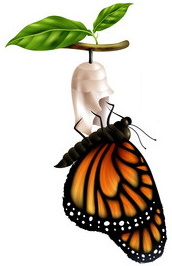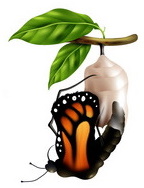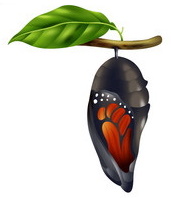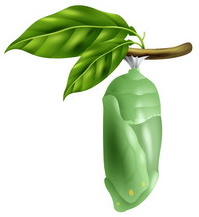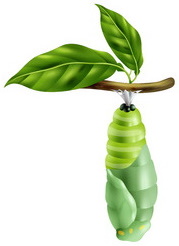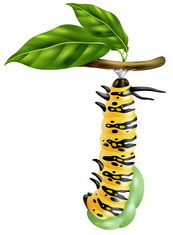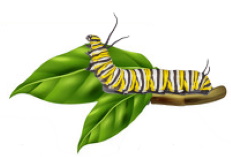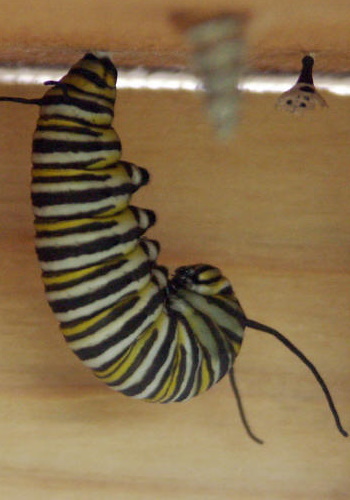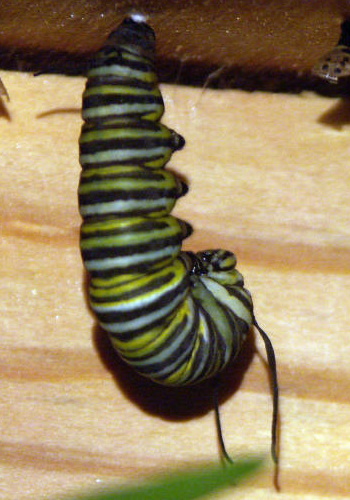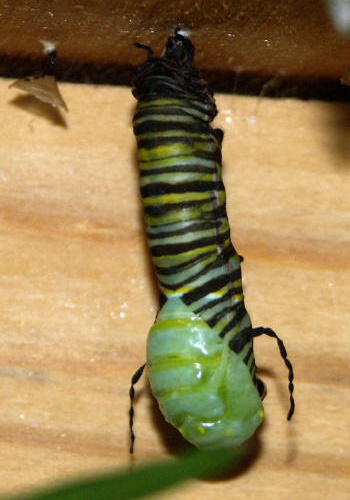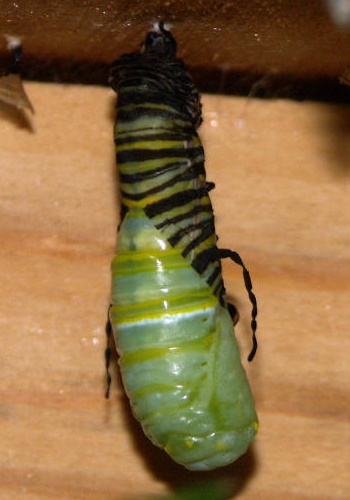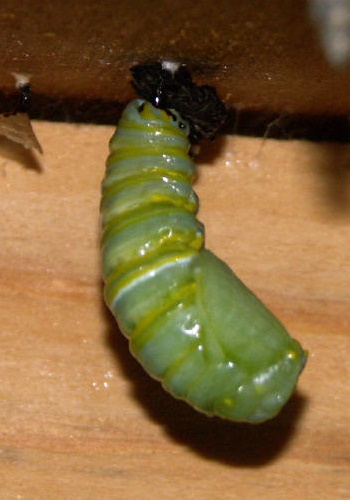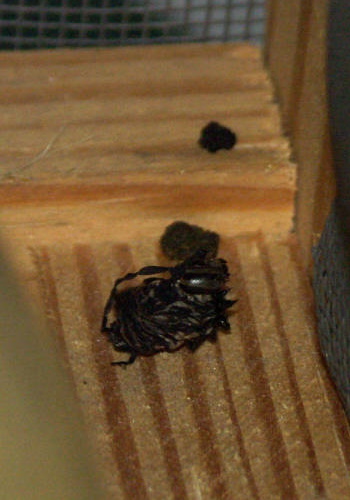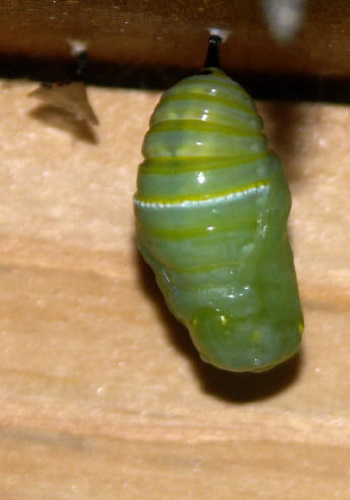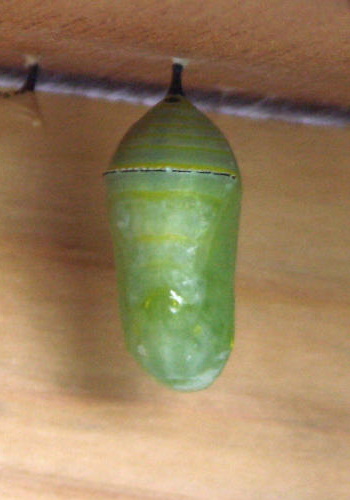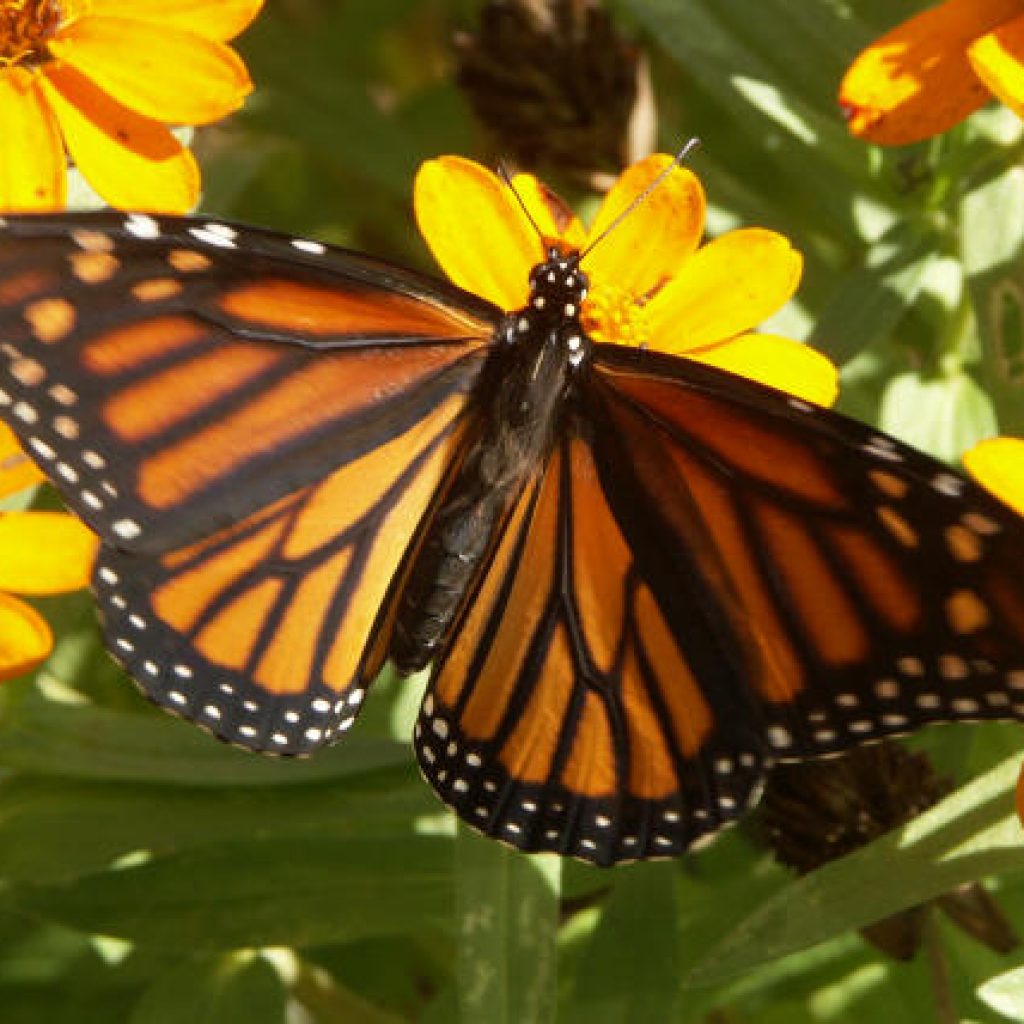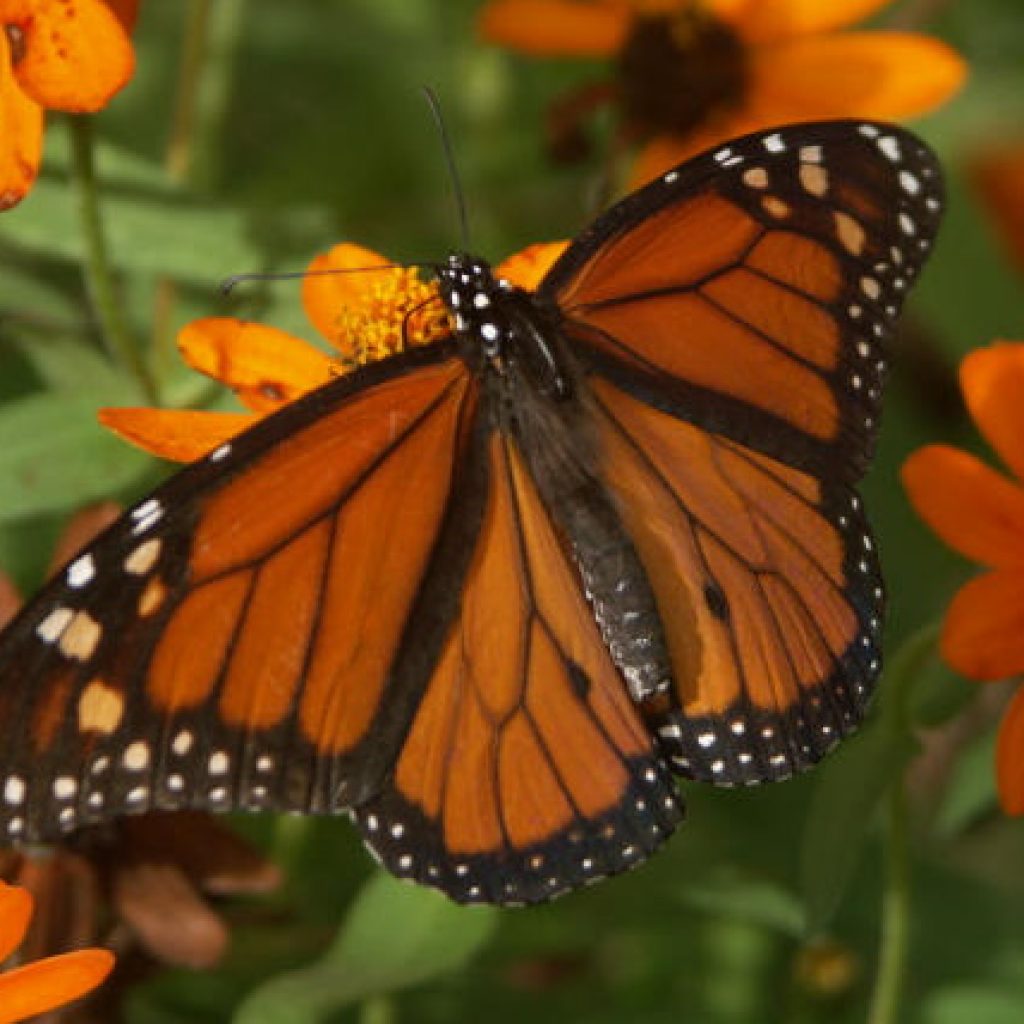The monarch butterfly has one of the best-known life cycles in the insect world. During mid-summer, the process goes from egg to adult in a month or so. The butterfly has a lifespan of 60–70 days during the summer, but this extends to 6–7 months if the butterfly pupates in autumn.
The female monarch butterfly lays each of her eggs individually on the leaf of a milkweed plant, attaching it with a bit of glue she secretes. A female usually lays between 300 and 500 eggs over a two to five week period. After a few days, the eggs hatch into larvae, otherwise known as caterpillars in the butterfly world. The caterpillars’ main job is to grow, so they spend most of their time eating. They only eat milkweed, which is why the female laid her eggs on milkweed leaves in the first place. The caterpillars eat their fill for about two weeks, and then they spin protective cases around themselves to enter the pupa stage, which is also called “chrysalis.” About two weeks later, they finish their metamorphosis and emerge as fully formed, black-and-orange, adult monarch butterflies.
Monarch butterflies do different things depending on when they complete their metamorphosis. If they emerge in the spring or summer, they’ll start reproducing within days. But if they’re born in autumn, they know winter is coming – time to head for warmer weather.
Eggs and Caterpillars
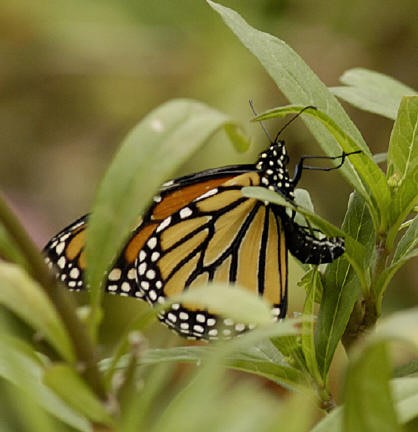
Monarch butterfly laying an egg
Monarchs lay their eggs only on milkweed plants as monarch caterpillars will only eat milkweed. Female monarch butterflies lay 300-500 eggs over two to five weeks.
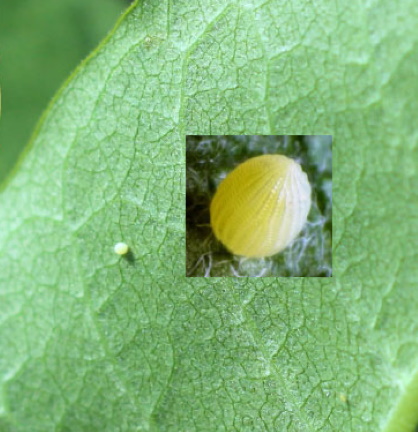
Monarch egg
The eggshell is hard and has a wax coating to protect the egg from drying out. The eggs are not much bigger than a pin head, and are cream coloured.
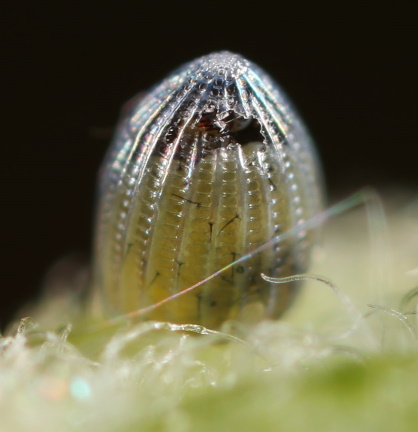
Egg ready to hatch
After 3 - 5 days the egg "shell" has become transparent and the baby caterpillar can be seen inside. The large black area is its head and the black body hairs can be seen also.
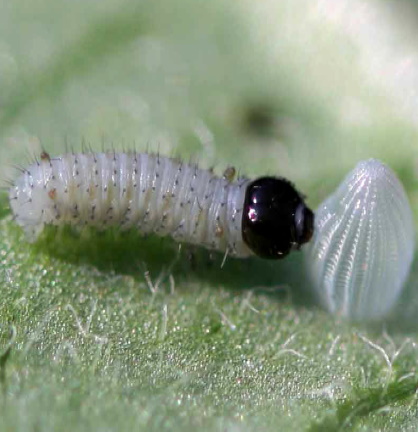
Newborn caterpillar
The larva's first meal, immediately after it hatches, is its egg case, which provides it with vital nutrients.
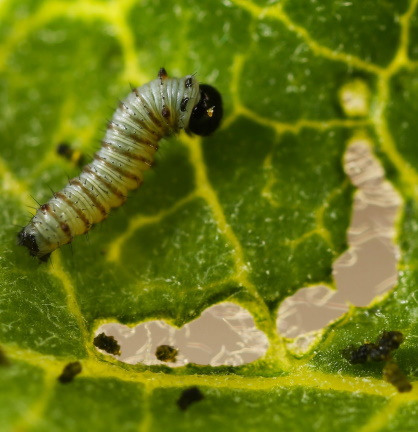
First food
After eating the shell, the larva begins to eat milkweed leaves. Milkweed is the only plant that monarch larvae will eat.
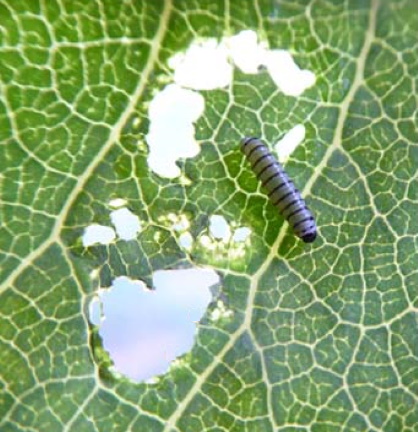
Eating, eating, eating...
The larva eats and grows, grows and eats. The larva grows so much that it outgrows its skin, much like outgrowing old clothes.
Caterpillar Moulting and Instars
In order for the larva to keep growing, moulting or shedding skin must occur. The old skin splits, revealing the new skin underneath. The larva wriggles free of the too-tight skin. At first, the new skin is very soft, and provides little support or protection. The new skin soon hardens and molds itself to the caterpillar. After freeing itself, the moulted larva often eats its old skin before moving on to more milkweed leaves.
After shedding their skins, monarch larvae continue to grow and will have to moult four more times. The intervals between moults are called instars. Monarchs go through five instars.
Body Length: 2-6mm Body Width: 0.5-1.5mm Front Tentacles: Small bumps Back Tentacles: Barely visible Head Capsule: 0.6mm in diameter
Body Length: 6-9mm Body Width: 1-2mm Front Tentacles: 0.3mm Back Tentacles: Small knobs Head Capsule: 0.8mm in diameter
Body Length: 10-14mm Body Width: 2-3.5mm Front Tentacles: 1.7mm Back Tentacles: 0.9mm Head Capsule: 1.5mm in diameter
Body Length: 13-25mm Body Width: 2.5-5mm Front Tentacles: 5mm Back Tentacles: 2mm Head Capsule: 2.2mm in diameter
Body Length: 25-45mm Body Width: 5-8mm Front Tentacles: 11mm Back Tentacles: 4mm Head Capsule: 3.5mm in diameter

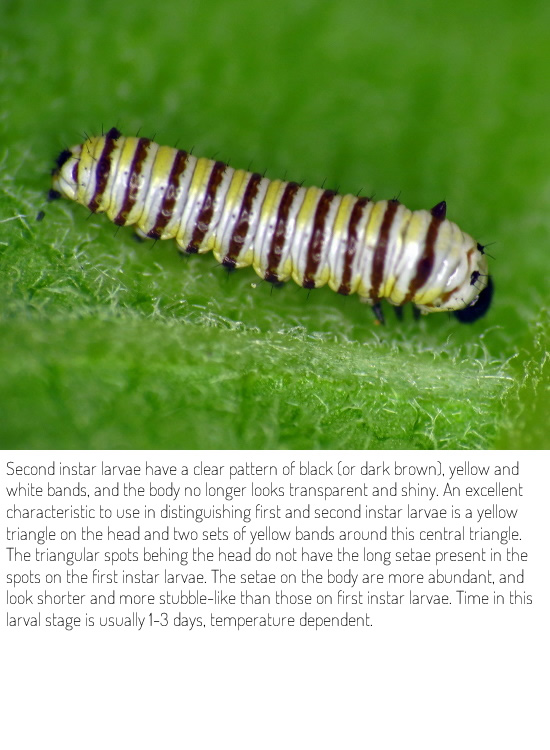
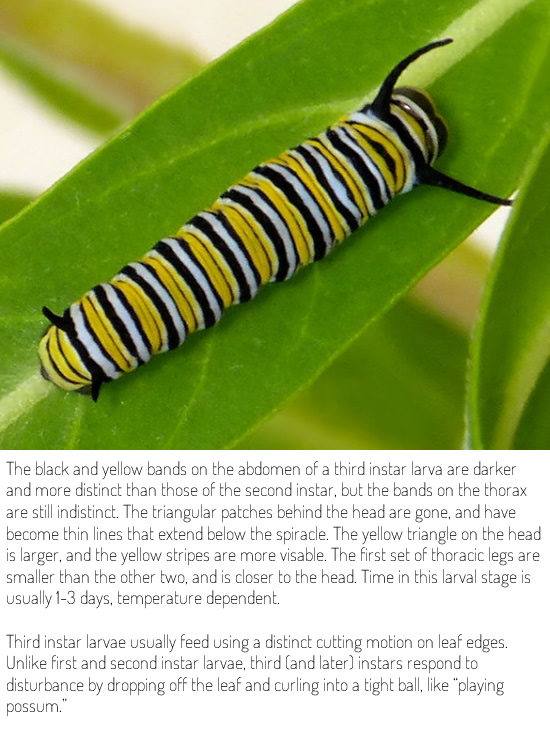
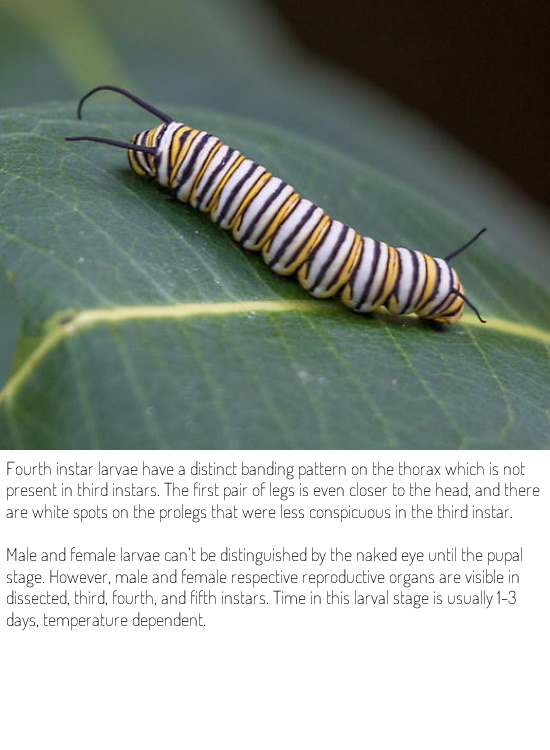
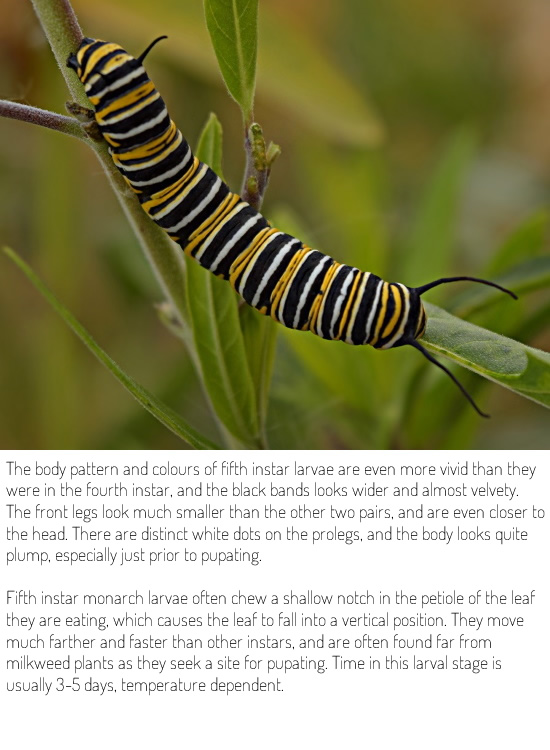
The Chrysalis
After about 2 weeks the caterpillar stops eating and begins to wander around the garden/enclosure. Once it finds a suitable place it will spin a silk mat from which they hang upside down in a J position by their last pair of prolegs. The silk comes from the spinneret on the bottom of the head. The caterpillar stabs a stem into the silk pad to hang. This stem extends from its rear end and is called the cremaster. The caterpillar hangs in this position for 12-24 hours. Then it sheds it’s skin for the last time and the chrysalis begins to form. When the chrysalis is first formed it is very soft and vulnerable. After a few hours it will harden.
The monarch has no eyes and no antennae. It has no legs, and it cannot move. All of the major changes in body shape, size, and arrangement happen. In monarchs, this stage can last as long as 3 weeks. At the end of this stage, an adult butterfly will emerge from the chrysalis.
Evolution of the Chrysalis
Continuous changes actually occur within the larva. The wings and other adult organs develop from tiny clusters of cells already present in the larva, and by the time the larva pupates, the major changes to the adult form have already begun. The chrysalis is jade green, studded with gold. The chrysalis starts out light green in colour, gradually darkening throughout the process. Just before the butterfly emerges, their black and orange wing patterns become visible through the pupa covering.




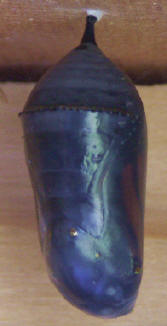
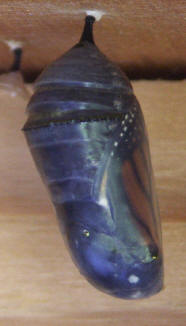
From Chrysalis to Butterfly
After about 14 days as a chrysalis, the monarch butterfly emerges. When the butterfly first emerges from the chrysalis, both of its wings are soft and folded against its body.
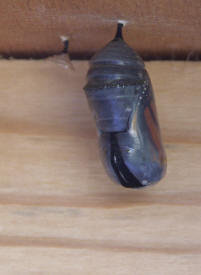
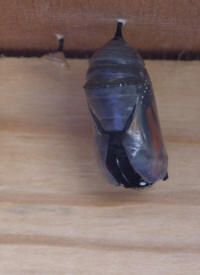
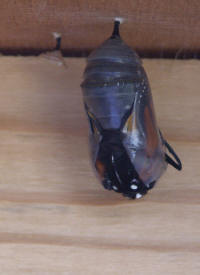
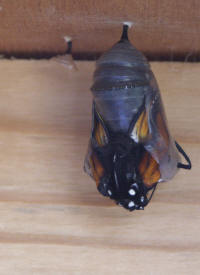
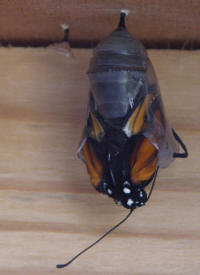
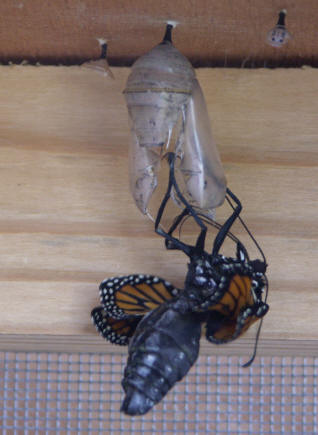
The Newborn Butterfly
The monarch can’t fly right away, it needs to inflate its wings and let them dry. It has to uncurl, stretch out and gain energy which can take up to 4 hours. Hanging on to its chrysalis, the monarch now proceeds to deploy its wings. It does that by pumping liquid stored in its abdomen into veins that will form the rigid structure of the wings. You can see the wings getting longer and more rigid.
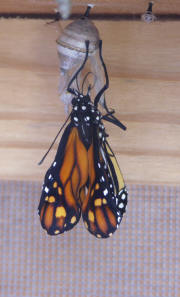
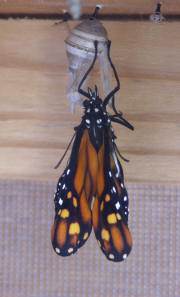
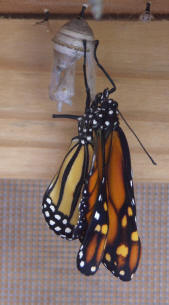
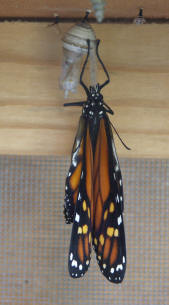
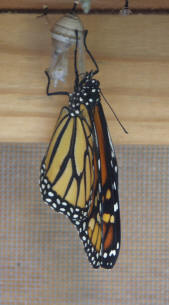
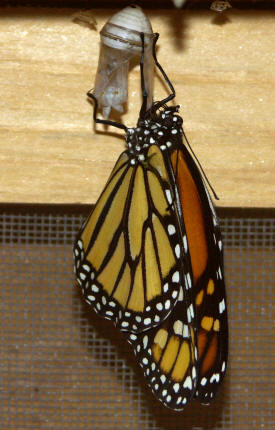
First Flight
Alright, little one, you are now free to go whenever you are ready! After a few hours, once fully dry and warmed up, the monarch begins opening and closing its new wings and will begin to fly. During this stage, butterflies need plenty of flowering plants so they can sip nectar.
First landing on a bush, just three feet away. Second flight will be a long one, taking him to the top of a nearby tree. We won’t be able to follow him anymore. It is time to say: “So long, beautiful butterfly! Have a wonderful life!”
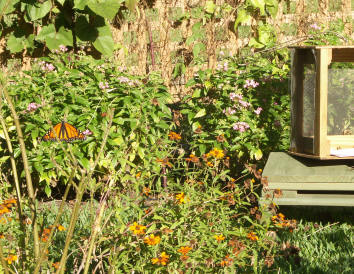
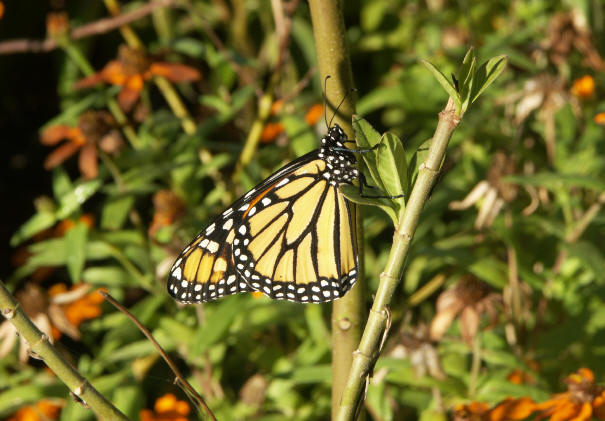
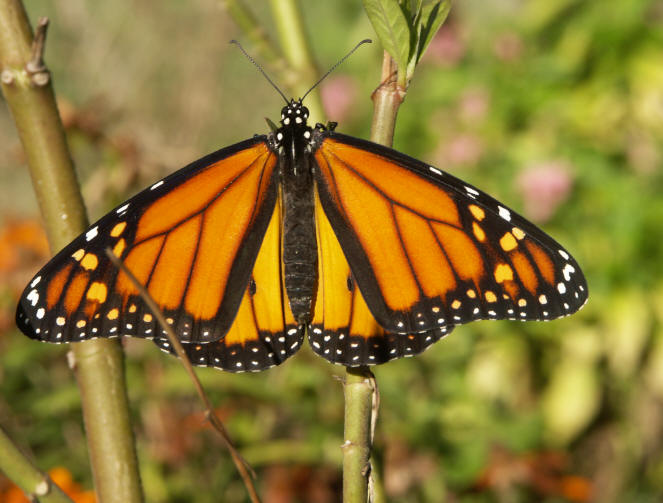
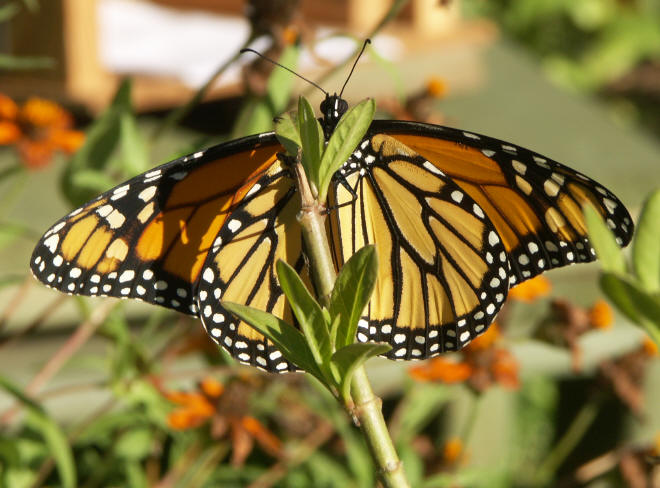
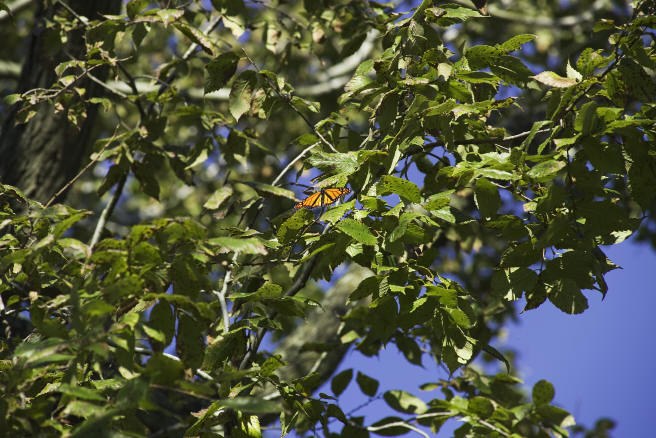
The Adult Butterfly
The primary job of the adult stage is to reproduce – to mate and lay the eggs that will become the next generation. Monarchs do not mate until they are three to eight days old. When they mate they remain together from one afternoon until early the next morning – often up to 16 hours! Females begin laying eggs immediately after their first mating, and both sexes can mate several times during their lives. Adults in summer generations live from two to five weeks.
Each year, the final generation of monarchs, adults that emerge in autumn, has an additional job. They migrate to overwintering grounds. Here they spend the winter clustered in trees until weather and temperature conditions allow them to return to their breeding grounds. These adults can live up to seven months.
Male and female monarchs can be distinguished easily. Females often look darker than males and have wider veins on their wings. Males have a black spot on a vein on each hind wing that is not present on the female. These spots are made of specialized scales which produce a chemical used during courtship in many species of butterflies. The ends of the abdomens are also shaped differently in males and females, on male monarch butterflies you can see a pair of claspers on the end of the abdomen. These appendages grasp the female during mating.
Female Monarch
Females have thicker wing veins than males and lack the black spots on the lower (hind) wings.
Male Monarch
Males have thinner wing veins than females do. The males also have two distinct black spots on the lower (hind) wings.

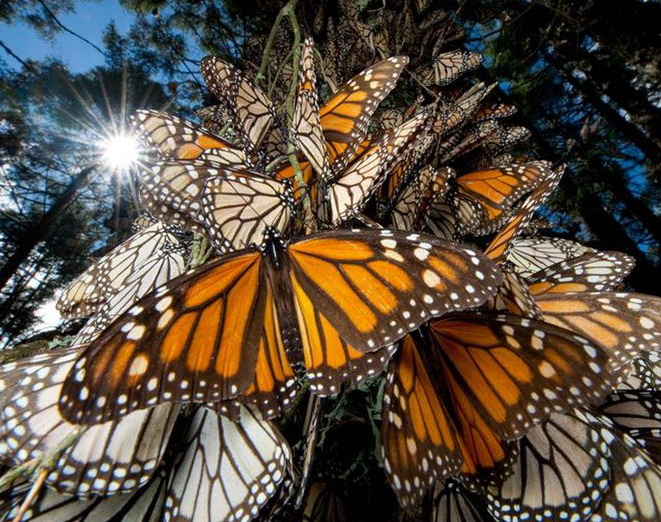 Monarchs are sensitive to air temperature. Their growth is the strongest in warm weather, and cooler temperatures signal a change in behaviour. Monarch butterflies in North America migrate from the colder northern regions to overwinter in California and Mexico, with some of the butterflies travelling thousands of kilometres! During migration, a Monarch can soar to 11,000 feet (more than 3,300 meters) and spend a lot of time gliding, using warm, thermal air currents the way that hawks do. As the temperature warms, they return north to reproduce. Monarchs know the correct direction to migrate even though the individuals that migrate have never made the journey before. They follow an internal “compass” that points them in the right direction each spring and autumn. The butterflies have a pair of molecules that are sensitive to the earth’s magnetic field, like a compass. They use these molecules and information from the position of the sun to find their way. The monarch migration is one of the greatest phenomena in the natural world.
Monarchs are sensitive to air temperature. Their growth is the strongest in warm weather, and cooler temperatures signal a change in behaviour. Monarch butterflies in North America migrate from the colder northern regions to overwinter in California and Mexico, with some of the butterflies travelling thousands of kilometres! During migration, a Monarch can soar to 11,000 feet (more than 3,300 meters) and spend a lot of time gliding, using warm, thermal air currents the way that hawks do. As the temperature warms, they return north to reproduce. Monarchs know the correct direction to migrate even though the individuals that migrate have never made the journey before. They follow an internal “compass” that points them in the right direction each spring and autumn. The butterflies have a pair of molecules that are sensitive to the earth’s magnetic field, like a compass. They use these molecules and information from the position of the sun to find their way. The monarch migration is one of the greatest phenomena in the natural world.
Unlike their northern relatives, when the air temperature drops to 12-13°c monarchs in New Zealand migrate to local overwintering grounds in more temperate locations including Christchurch, Nelson, Napier and Tauranga Bay Northland. The temperature in these regions doesn’t typically go below 10°C. They have adapted their behaviour to suit local conditions. There, they huddle together on trees to wait out the winter. Overwintering monarchs prefer sites that are sheltered from the wind, have trees with a rough bark surface on which to cling and have a nearby source of nectar. The butterflies are mostly inactive, but on warm days, they fly, bask in the sunlight and feed. When the temperatures warm up, butterflies become active again to reproduce.
Winter Life Cycle
Last generation monarch butterflies emerges from pupae around April/May.
They feed as long as they can until winter sets in.
Prolonged winter temps below 12-13°c will make them look for a hibernation place, usually a park or a group of tall trees.
There they tend to congregate in variable numbers and simply hang from twigs and branches for day after day. Sometimes weeks and weeks.
They only start flying when it really warms up in the middle of the day/afternoon, before returning to their hibernation spot again to conserve energy.
When spring arrives, the butterflies (often quite frayed-looking) find a mate and start laying eggs again.


